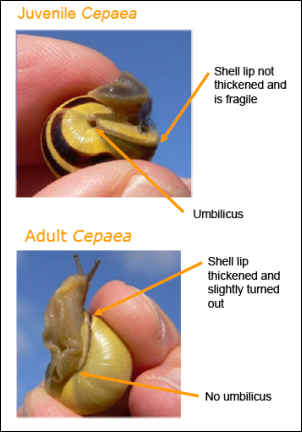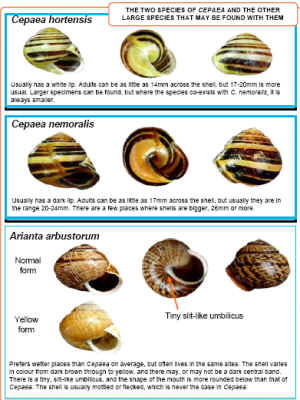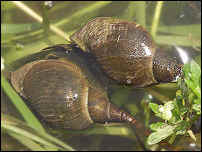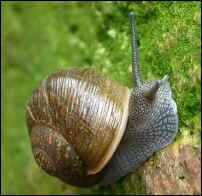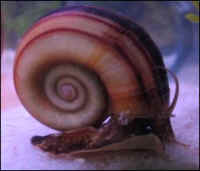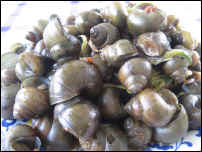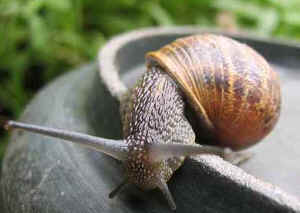
Garden Snail
SNAIL & SHELL CREATURE DOSSIER
“Snails are well known for invading our gardens at almost any time of year, especially the large ‘Garden Snail’ (pictured), but some have exquisitely-coloured shells and deserve a closer look.”
SNAILS IN COOKHAM
Anyone with a garden or allotment knows all about the ongoing war with those armour-plated destroyers, the snails, seeking as many control measures as possible, including beer traps, salt bombs, or the tried and tested method of collecting them – and hurling them onto a neighbour’s plot!
But how much do we know about them and their fascinating lives. Well, we have a wonderful opportunity to find out by virtue of a national survey being organised by Open University, which we encourage citizens to get involved with. But first, what is a snail and how does it live.
There are no less than 80,000 mollusc species world-wide, living both on land and under water. Slugs belong to the same family, but tend not to bother with a shell. To move around, it is essential for a snail to retain a wet skin, and to achieve this it picks up moisture mainly through the vegetation it munches as it goes. Their shells are an amazing piece of construction, continually extending to match the growing body inside, forming a protection when the animal withdraws itself.
Newly hatched ‘snail-lets’ already have a shell which is actually formed in the egg. This then continues to grow as the snail lays down material fashioned from its diet. During the years taken to reach adulthood, growth takes place at different times of each year, and the ‘breaks’ between seasons can often be seen in the form of growth lines on the shell. Although not obvious, the shell has two layers. The inner layer is essentially a thick layer of calcium carbonate (chalk) and offers the main protection. The outer layer resembles a coat of transparent varnish and keeps the shell fresh-looking. The shell itself is dead and inert.
Most species of snail can be identified from its shell, by means of its colouring, the number of whorls formed and the direction of the coiling itself (almost always the same direction within any species).
The animal lurking inside is of course instantly recognisable when it emerges. Its most distinctive feature is the ability to withdraw or extend its eyes which are mounted at the end of two manoeuvrable tentacles, a useful feature which I would use for seeing round corners if I possessed it!
The ‘land snails’ are, by definition, mainly found in or on our garden foliage, or just beneath the surface of the soil where they can get at roots. But there are also shell-carrying creatures in the waters around the Cookhams. A good way of finding these is available to us at the moment following recent dredging of the stream through Widbrook. The soil remnant alongside the stream still holds plenty of shells from a small variety of species that live in the WhiteBrook. A collection of these sent off to an ecologist for identification in previous years of dredging revealed the following species:
Great Pond Snail (Lymnaea stagnalis)
Terrestrial Snail (Monacha cantiana)
Great Ramshorn Snail (Planorbis corneus)
River Snail – (Viviparus viviparous)
Why not have a look on the Common and see how many different ones you can find?
BANDED SNAILS
Without doubt, the most attractive snails are those with small, colourful shells having a variety of bands around them, and a major national project has been established to enable citizens to conduct their own local surveys and contribute their findings to a national database.
The Open University and Evolution MegaLab have combined forces to create a series of resources to enable us all to take part. I hope you will.
Advice on how to hunt snails out and what to look for to identify them (click here).
It's even possible to tell adults from juvenile snails as the next section shows us (click here).
Hunting and identifying these colourful creatures can be fun for all the family, and if your records are entered onto the on-line facility at the project web site (www.evolutionmegalab.org) your report will form part of the citizen-science results for this important topic.
So, do please get involved, and please also let us know what you find for the Cookham Wildlife Dossier.
|
ADULTS V JUVENILE SNAILS HOW TO TELL THEM APART
Click here for a .pdf info sheet
|
|
|
HOW TO HUNT BANDED SNAILS
Click here for a .pdf info sheet
|
|
|
GREAT POND SNAIL |
|
|
TERRESTRIAL SNAIL |
|
|
GREAT RAMSHORN SNAIL |
|
|
RIVER SNAIL |
|
|
|
|
